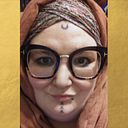My body is not a land waiting for a flag
“I am Still Here”- mixed media (acrylic on canvas, hand embroidery, beads, wax, wooden embroidery hoop frame), 2014, Aaminah Shakur
***
Trigger/Content Warning: The following is an experimental spoken word piece originally written in January 2014, performed once in February 2014, and significantly re-written in October 2016. It tells a true story about rape, colonization, and anti-Indigenous racism.
I was working on this with the intent to share it for the day known by some as Columbus Day, and by others as Indigenous Peoples’ Day, when the story of Donald Trump’s 2005 hot-mic conversation about pussy grabbing dropped (extra TW on that link.) In light of how sexual violence is being discussed and many survivors are being asked to share their stories, I considered NOT sharing this right now. I’m not comfortable with the demand being placed on survivors to tell all right now, and I’m not comfortable with how women of color (and non-binary folx of color, like myself) are having our experiences of sexual violence pushed to the side to center the white women Trump was talking about. If it took you to *this* point to realize what a terrible person and catastrophic presidential candidate Trump is, your protests are too little, too late to redeem you. Then I realized, this is exactly why I feel compelled to share this particular piece right now. The sexual violence that Trump so glibly jokes about has a LONG history in this country — and some of us are more likely to experience it than others. Four out of five Indigenous women have experienced violence in their lives, are 2.5 times more likely than white women to have been raped, and the vast majority of them have experienced more than one incident. Columbus set the stage, and contemporary Indigenous people continue to face gender and racial violence, including rape and sexual violence, while perpetrators of that violence remain predominantly white men (see previous link again.) It is for this reason that I decided to go forward with my plan to share this now.
Again, the following contains references to and descriptions of racialized sexual violence and rape.
***
“Want to meet my friend? His name is Christopher Columbus.”
This was not my first introduction to the male anatomy or abuse. I was about 8 or 9. I can’t remember for sure. He was a new next door neighbor, 10 or 11. I don’t even remember his name, but I can still picture these moments clearly.
We were sitting on the grass and scraping the old paint off my parents’ garage for a few dollars when he asked me. It’s a wonder I don’t detest the scent of the lilac bushes that half hid us while he made this overture.
“Christopher Columbus was a murderer and evil man,” I answered. My white adoptive dad had filled in the gaps that our school books left out.
“No, he was just an explorer. My friend likes to explore new things,” he responded.
It took me decades to process what it means that a “friend” who knew I was Native didn’t think anything of calling his penis Christopher Columbus and inviting me to play with “his friend”.
My response remained a firm “no”. I had seen penises before and I was not only unimpressed but also repulsed by the particularities of his offer.
On another occasion when his parents weren’t home, we explored his mom’s bedroom with my best friend and brother along. We were fascinated by the taboo. The bathroom was accessible only from her room and he said I should see it.
This playmate forced me onto the pink bath-mat on his bathroom floor and used “Christopher Columbus” to assault me, while holding his hand over my mouth, and telling me that I was lucky Columbus thought I was “pretty for a squaw”.
It took me decades to be able to explain why the word “slut” isn’t one I feel compelled to reclaim, but the word “squaw” still creates a visceral reaction in me.
I have had visions of my ancestors chased down by white settlers and U.S. military, have woken screaming in their voices and languages, feeling the pressure of dirty men on top of me/them and tearing apart my/their bodies with versions of “Christopher Columbus.” My own trauma mingles with the trauma of my foremothers.
It wasn’t until decades later that I also learned that this neighbor had done the same to my brother and to my best friend. They both had shallow memories of a pink bath-mat, a shower curtain with pink butterflies, cold white tile, and being told that Christopher Columbus was a great explorer and wanted to chart their territory.
He was not the first or the last to abuse me. He was not even the last to call me a squaw and make it clear that my body was seen as something to be conquered, something not sovereign or my own.
My body is not a land waiting for a flag. It is owned by no one but myself and I am hostile towards those who wish to lay claim to it, to own it, to do with it as they please. As an Indigenous warrior, I resist all colonization, of myself and of future generations.
It took me 30 years to speak of this.
